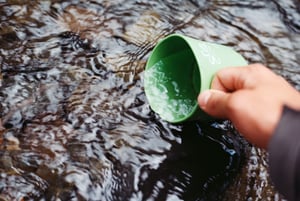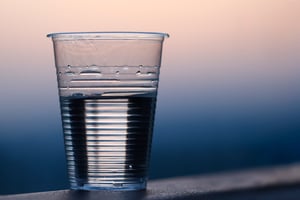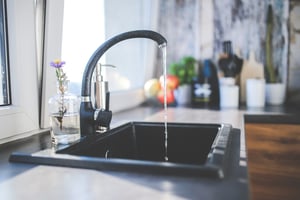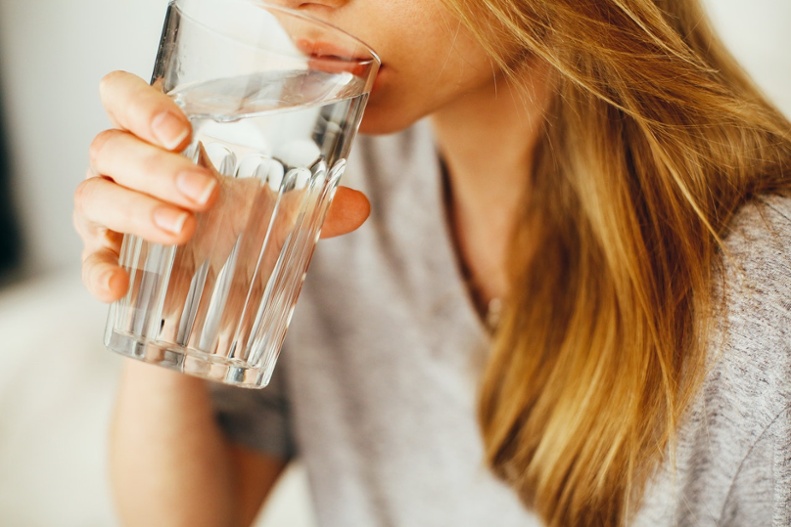These days, most people carry a drink with them wherever they go. Every food shop, however small, has a fridge packed with bottled beverages. Some people drink large quantities of sugary soft drinks, others can’t get through the day without copious quantities of coffee, and tea drinkers are happy to respond to recent experimental evidence that suggests tea is a healthy source of liquid sustenance for the human body. However, for purposes of hydration, the most popular choice is water.
Hydration status
The message that hydration is good and dehydration is bad, has been received, understood and acted upon. But why is it so important?
The total amount of water in the human body varies depending on a number of factors, including age, sex, body weight and health. On average, it’s about 60%, but can range from 50 to 75%. Adult women have a higher water percentage than adult men or babies, because their bodies contain more fatty tissue. Two thirds of this water is found inside cells and one third is extracellular, occurring, for example, in the gut, lymph, blood and cerebral fluid. About 2 to 3 litres of water are lost by the body in a typical day, due to processes such as breathing, defecating, urinating and sweating.
Symptoms of dehydration
The European Hydration Institute says that normal hydration, known as euhydration, is important for health and wellbeing, and that even small levels of dehydration can negatively affect muscle strength, endurance and maximal oxygen uptake.
Dehydration is frequently accompanied by disturbances in mineral salt or electrolyte balance; levels of sodium and potassium are particularly affected. It can also affect cognitive performance. One investigation showed that even mild levels of hypohydration caused an increase in minor errors during a monotonous driving task, accompanied by impaired alertness and concentration; the effect was comparable to that obtained after drinking an alcoholic beverage that would lead to a blood alcohol content of 0.8% - the current UK legal limit for driving.
Mental performance and physical coordination may become impaired when the body is around 1% dehydrated – interestingly, this is likely to happen before thirst kicks in, which tends to occur at a dehydration level of 2-3%. This level of dehydration is normally corrected within 24 hours, both by drinking to compensate for thirst and reduction of water loss via the kidneys.
As well as thirst and cognitive impairment, mild dehydration can lead to headache, dizziness, weakness, tiredness and lethargy. Moderate dehydration is more serious; symptoms of this can include a dry mouth, little or no urination, a rapid heartbeat, sluggishness and reduced skin elasticity. Severe dehydration is a medical emergency and can be characterized by absence of urination, extreme thirst, an altered mental state, cold, clammy skin and rapid breathing.
The thirst mechanism
Clearly dehydration is a problem we should try and avoid, but can we rely on the thirst mechanism to maintain a balance or should we prevent even mild dehydration by remembering to drink water regularly even when we don’t feel thirsty?
Our response to thirst is not always straightforward. In an ideal world, the complex physiological and homeostatic mechanisms that lead to thirst, followed by water intake, should be sufficient to maintain optimal hydration status. However, some studies suggest that humans don’t always respond to physiological thirst signals for various reasons, such as dislike of water, lack of available toilets when travelling and absence of an accessible water supply. Some people may not be aware that fluid intake is important and others simply forget to drink. Also, the thirst response to a fluid deficit decreases with age, and can be affected by certain drugs.
All of this suggests that a habit of anticipating the body’s need for water, by drinking at regular intervals, whether thirsty or not, may be a good habit to get into. However, in certain disease states, where fluid restriction is necessary, even drinking in response to thirst may cause problems.
 How much should we drink?
How much should we drink?
Most sources suggest we should drink 8-10 glasses of fluid per day. A common misperception is that this means drinking water alone. The average person obtains about 50% of their fluid from water. The rest comes from other drinks (30%) and solid foods (20%).
Is it possible to drink too much?
As we have seen, people can override the physiological mechanisms that should make us respond to thirst by not drinking, resulting in dehydration. However, people can also do the opposite – drink when they’re not thirsty.
Intake of excessive amounts of water without the accompanying electrolytes can lead to water intoxication and hyponatremia. This can happen, for example, when athletes sweat heavily, losing both water and electrolytes and then quench their thirst by drinking copious amounts of water without the accompanying electrolytes. It can also occur when infants drink several bottles of water in one day and in other, more unusual circumstances, such as college drinking contests. Water intoxication causes increases in intracellular fluid levels. This can lead to a rise in intracranial pressure, evidenced by headaches, confusion, irritability and drowsiness. In extreme cases, severe central nervous system dysfunction can occur, resulting in death.
However, although a number of fatalities occur every year, accidental consumption of excessive amounts of water is actually very rare.
Bottled water
Bottled water is the world’s most popular soft drink. In the UK, a country that has a plentiful supply of clean tap water, consumption of the bottled variety has reached 2.6 billion litres. Many consumers believe that bottled water is healthier than tap water and has a better flavour. It also has a pure and natural image that people find attractive. In the US, researchers found that reports of domestic water quality violations made American households 25% more likely to purchase bottled water.
Another reason for its continuing popularity may simply be its availability. Out of the home it’s often much easier to buy a bottle of water than to find a drinking water tap.
Mineral water
Nearly half of all bottled water is thought to come from a public drinking water supply – it is, in actual fact, packaged tap water. In many parts of the world, the term “mineral water” is used to describe any bottled and carbonated water or soda water.
 However, in the US, the Food and Drug Administration defines mineral water as water containing at least 250 parts per million dissolved solids from a geologically and physically protected water source. The European Union defines mineral water as any water that has been bottled at source with minimal treatment. No process is allowed that alters the composition of minerals giving the water its peculiar characteristics. CO2 may be added, removed or re-introduced by physical methods, but neither disinfection nor the addition of preservatives is allowed. In the UK, most bottled water comes from protected, natural, underground sources and is piped directly from the source to the bottling facility, where none of the materials or processes used are allowed to affect the original composition of the water.
However, in the US, the Food and Drug Administration defines mineral water as water containing at least 250 parts per million dissolved solids from a geologically and physically protected water source. The European Union defines mineral water as any water that has been bottled at source with minimal treatment. No process is allowed that alters the composition of minerals giving the water its peculiar characteristics. CO2 may be added, removed or re-introduced by physical methods, but neither disinfection nor the addition of preservatives is allowed. In the UK, most bottled water comes from protected, natural, underground sources and is piped directly from the source to the bottling facility, where none of the materials or processes used are allowed to affect the original composition of the water.
Flavour and mouthfeel
Different types of mineral water have their own particular mineral composition, due to the geological characteristics of their source. The minerals present influence the mouthfeel and flavour of the final product. For example, exposure to volcanic rock leads to high sodium levels, which may cause bitterness, whereas limestone confers sweetness. In one study, a correlation was observed between Ca concentration and perceived freshness.
In another investigation, participants were found to prefer samples with moderate contents of total dissolved solids and relatively high levels of Mg2+, Ca2+, sulphate (SO42-) and bicarbonate (HCO3-). Many panellists gave low scores to samples with high Na+, K+ and Cl- concentrations.
A wide range of mineral water brands are available. Perrier is one of the most well-known of these; naturally carbonated, it originates from a spring in southern France. San Pellegrino is obtained from 3 deep springs at the foot of the Dolomites in Italy, where it is thought to be mineralized through contact with limestone and volcanic rock 400 metres below the surface, whereas Malvern Water, from the Malvern Hills in the UK, is derived from rainwater that permeates through very hard granite and limestone rock, leaving it with a very low mineral content – it is marketed as containing “just nothing at all”.
A quick look at the websites reveals common threads in the marketing strategies adopted for these brands - words like “natural” and “pure” are used, details of product history are provided and the source of the water is also emphasized.
Is mineral water a healthy option?
Whether or not it’s worth drinking mineral water for health reasons may depend on the composition of tap water in your area – and on the mineral content of the bottled water you decide to drink.
Concerns have been raised that switching from tap water to bottled water may lead to Mg deficiency, but the National Hydration Council of the UK states that neither bottled nor tap water are significant sources of Mg in any case, so switching from one to another won’t have a significant impact on the drinkers Mg levels.
However, a French study discovered that some natural mineral waters have high levels of calcium and magnesium in forms shown to be bioavailable, leading the authors to suggest they could be used to increase intakes of these minerals.
Another study, also from France, suggested that calcium-rich mineral water could be used to improve bone health.
The question of sodium
Concerns have been raised that mineral water, particularly the sparkling varieties, may contain unhealthy levels of salt. However, the vast majority of commercially available mineral waters contain sodium levels that fall well within current guidelines and are not believed to pose a risk to the consumer.

A survey conducted in the UK revealed that tap water and commercially available mineral waters contained varying levels of salt. From the data provided in this survey, it is impossible to conclude that mineral water contains higher levels of salt than tap water, or vice versa.
Nevertheless, it is considered possible that a “heavy user” of mineral water brands containing sodium may increase their intake of the mineral to undesirable levels.
Deep sea water/deep ocean water
Water drawn from the depths of the ocean has contents of various salts and pH comparable to those of human blood. It is said that it was used by Navy doctors instead of blood transfusions during WWII when no donated blood was available. A typical example is Kona Deep, a branded deep ocean water bottled at its source - Kona, Hawaii. It is pumped to the surface via a special pipe and desalinated using reverse osmosis. Other than that, its natural mineral and inorganic nutrient content is preserved.
Very few scientific studies have investigated the benefits (or otherwise) of this type of water. However, one piece of research suggested that after exercise, it led to a faster return to a pre-exercise hydration state and improved recovery of lower body muscle performance to a greater extent than either spring water or a carbohydrate-based sports drink.
Another group of researchers found that the addition of deep sea water to yogurt enhanced its beneficial impact on health-related serum parameters in mice.
Microbial contamination
A widespread belief exists that bottled water is safer to drink than tap water. In most developed countries, bottled water is considered to be a food product and must comply with strict safety requirements. In the UK, each commercially available brand of bottled water is subjected to hundreds or thousands of tests every year. Nevertheless, many studies suggest that rapid growth of microorganisms can occur in water after bottling.
Public water supplies in developed countries, such as the US and the UK, are generally considered to be safe from microbial contamination, but tap water contamination incidents do occur from time to time. According to the Centres for Disease Control in the US, water-related disease outbreaks between 1971 and 2010 arose due to the presence of a range of pathogens in public water systems, but the top three in terms of frequency were Giardia, Legionella and norovirus.
Migration compounds
Mineral water is usually stored in bottles made from plastics, usually polyethylene terephthalate (PET), but also polycarbonate or high density polyethylene. Concerns have been raised that harmful compounds can migrate from the plastic to the water, particularly after long periods of storage.
Antimony can migrate into water from PET, but modelling studies have shown that the final levels reached are too low to be harmful.
Carbonyl compounds, such as acetaldehyde and formaldehyde are found in water stored in PET bottles, but usually at levels within acceptable limits.
In one study, estrogenic activity of spring water stored in PET bottles was found to be 3 times higher than that of the same water stored in glass bottles, suggesting that PET is a source of oestrogenic compounds. The authors concluded that the amounts of oestrogenic compounds present were low, but that the potential harm they could cause to certain population groups after long term consumption was unknown.
Another investigation using reporter gene assays detected endocrine disruptors in 78% of samples tested – 42 samples from 14 brands of bottled mineral water. They concluded that the levels of oestrogenic, androgenic and progestagenic activity present were not harmful but they were unable to say whether the levels of glucocorticoids detected were safe.
Tap water
 Tap water comes from a variety of sources. In the UK, about half of it comes from reservoirs and rivers. Unlike mineral water, it is chemically treated - chlorine is added in small amounts to kill bacteria. In some regions, fluoride may be added, whereas in other areas it occurs naturally. Various minerals are also naturally present.
Tap water comes from a variety of sources. In the UK, about half of it comes from reservoirs and rivers. Unlike mineral water, it is chemically treated - chlorine is added in small amounts to kill bacteria. In some regions, fluoride may be added, whereas in other areas it occurs naturally. Various minerals are also naturally present.
Hardness
Hard tap water contains relatively high levels of Mg and Ca. Rainwater is soft but as it falls it picks up the minerals that contribute to hardness, such as Ca and Mg. The amount it picks up depends on the geology of the area. Soft water can be defined as having a Ca content of less than 30 mg/l, compared to very hard water at 120 mg per litre. Water at both extremes is drinkable, but soft water makes a better cup of tea than hard water.
Should we filter our tap water?
In many parts of the world, domestic consumers rely on filters to make their water safe to drink. However, some people also use filters in developed countries, despite the fact that the tap water coming into their homes is generally considered to be safe.
Unfiltered tap water is by no means pure. It may contain chlorine, disinfection by-products, various metals, nitrates, phosphorus and bacteria. Although most of these are harmless, research has suggested that some of the chemicals present, such as disinfection by-products, may be carcinogenic or lead to a range of other adverse health effects. Domestic water filters will remove disinfection by-products from tap water, but these compounds are present in amounts so small they are extremely unlikely to have a negative health impact anyway.
Water filters will also adsorb minerals, thus reducing limescale accumulation on kitchen equipment, such as kettles and steamers. However, the loss of minerals is not necessarily a good thing. For example, the flavour of water is enhanced by the presence of minerals – for this reason, distilled water is thought by many to taste dreadful!
In a study investigating the impact of mineral composition and content on drinking water quality, it was found that reductions in mineral content led to changes in perception of water from fresh to bitter, with dry and rough sensations.
Some experts also believe that use of purified water as a hydration source may lead to inadequate intake of electrolytes and trace elements, particularly when these are not being absorbed via food intake. In one study, for example, long term consumption of mineral water with a low mineral content led to weakened bone biomechanical properties in female rats.
Many consumers think that domestic filters improve the microbiological quality of tap water. However, one study compared levels of bacteria in tap water and micro-filtered water from a dispenser. Microbial quality of the filtered water was significantly poorer than that of the tap water – it contained higher mean heterotrophic plate counts than tap water, and a higher incidence of Pseudomonas aeruginosa was found.
So what should we be drinking?
The internet is full of passionately worded blogs and adverts promoting mineral water and filtered water and casting doubt on the quality of the drinking water coming into our homes. Scientific opinion is much more nuanced, though, as can be seen from the studies quoted above.
In most of the western world, extensive consumption of mineral and filtered waters is relatively recent development. In the UK and similar countries, consumers have been drinking tap water for decades with few ill effects, apart from those arising from isolated contamination incidents. Another important factor consider is cost - tap water is much cheaper than mineral or filtered water.
Taking all this into consideration, I think I’ll stick to tap water!
Related Posts:
(Image Credits: Daria Shevtsova from Pexels, Meir Roth, Jens Johnsson and Katii Bishop via www.pexels.com and www.pixabay.com)


